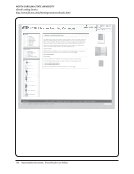34 · Survey Results: Survey Questions And Responses
e-Book Acquisition Methods
10. Which acquisition methods does your library (or a consortium on behalf of the library) use to build
e-book collections? Check all that apply. N=73
N Library
N=73
Consortium
N=50
Acquire collections/bundles direct from publishers 67 63 40
Acquire title-by-title from an aggregator 64 62 14
Acquire title-by-title direct from publishers 62 62 8
Acquire collections/bundles from an aggregator 58 54 36
Create new e-books in-house by digitizing print versions 43 41 6
Create new e-books with external partners (e.g., Google,
Microsoft) by digitizing print versions
31 26 13
Acquire title-by-title through an approval plan 29 29 1
Create new “born-digital” e-books in-house 18 17 1
Acquire collections/bundles through an approval plan 10 8 4
Other acquisition method 6 5 1
Please describe other acquisition method(s). N=6
A few e-books have been acquired as gifts. LC also provides access to Open Access e-books.
Addition of open-access e-books from other libraries by bibliographer selection and/or metadata harvesting.
Link to open access books currently available online, when and as discovered by selectors.
One of our consortia is exploring a patron-driven model and would like to base it on an approval plan model.
Patron driven purchase plan.
Patron-driven selection.
Please enter any comments on methods used to build e-book collections for your library. N=17
At the present time it is mostly (in terms of numbers) done via large packages directly from publishers (Books 24x7,
Knovel, Referex, etc.) or large historic digitization projects (EEBO, Wright, etc.). Individual titles are selected via
NetLibrary, but these can still be counted in the dozens (such individual title selection only began this fiscal year). This
spring, some series (Lecture Notes in Mathematics, for instance) have been turned over to e-copies only, again via the
publisher.
Born digital books created in-house are electronic theses.
By far the vast majority of our over 460,000 e-books were purchased as collections or bundles. Only in the last two
years have title-by-title purchases become more frequent. We anticipate that to accelerate in the near future.
e-Book Acquisition Methods
10. Which acquisition methods does your library (or a consortium on behalf of the library) use to build
e-book collections? Check all that apply. N=73
N Library
N=73
Consortium
N=50
Acquire collections/bundles direct from publishers 67 63 40
Acquire title-by-title from an aggregator 64 62 14
Acquire title-by-title direct from publishers 62 62 8
Acquire collections/bundles from an aggregator 58 54 36
Create new e-books in-house by digitizing print versions 43 41 6
Create new e-books with external partners (e.g., Google,
Microsoft) by digitizing print versions
31 26 13
Acquire title-by-title through an approval plan 29 29 1
Create new “born-digital” e-books in-house 18 17 1
Acquire collections/bundles through an approval plan 10 8 4
Other acquisition method 6 5 1
Please describe other acquisition method(s). N=6
A few e-books have been acquired as gifts. LC also provides access to Open Access e-books.
Addition of open-access e-books from other libraries by bibliographer selection and/or metadata harvesting.
Link to open access books currently available online, when and as discovered by selectors.
One of our consortia is exploring a patron-driven model and would like to base it on an approval plan model.
Patron driven purchase plan.
Patron-driven selection.
Please enter any comments on methods used to build e-book collections for your library. N=17
At the present time it is mostly (in terms of numbers) done via large packages directly from publishers (Books 24x7,
Knovel, Referex, etc.) or large historic digitization projects (EEBO, Wright, etc.). Individual titles are selected via
NetLibrary, but these can still be counted in the dozens (such individual title selection only began this fiscal year). This
spring, some series (Lecture Notes in Mathematics, for instance) have been turned over to e-copies only, again via the
publisher.
Born digital books created in-house are electronic theses.
By far the vast majority of our over 460,000 e-books were purchased as collections or bundles. Only in the last two
years have title-by-title purchases become more frequent. We anticipate that to accelerate in the near future.
























































































































































































